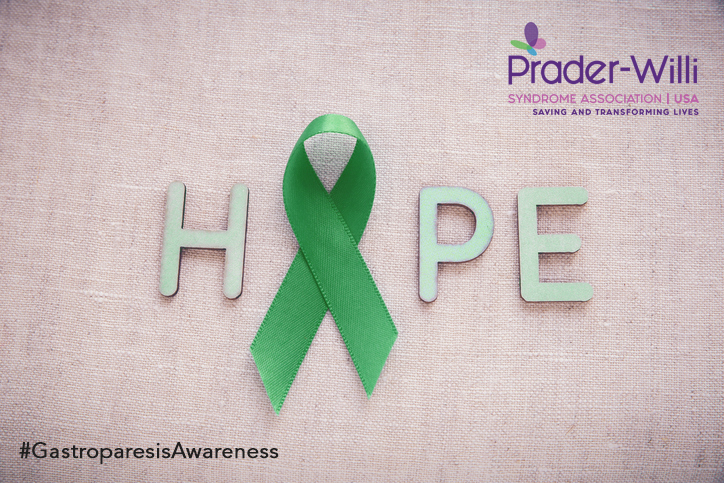Compiled and Reviewed by Barb Dorn, RN, BSN, Margaret Burns, RD, Prader-Willi Homes, and Dr. Ann Scheimann, MD
What is Gastric Motility and Gastroparesis?
GASTRIC MOTILITY is the rate at which the stomach empties.
GASTROPARESIS is slow emptying of the stomach. This condition occurs when there is a delay or slowing in the contraction of the stomach muscle. Because of this delay, stomach contents can build up, and distention or bloating can occur. High-fiber foods may remain in the stomach or may cause bezoar formation. A BEZOAR is a mixture of food fibers that may cause a blockage in your stomach and prevent it from emptying well.
How Do These Conditions Affect Children and Adults with PWS?
Gastric motility is slower in persons with Prader-Willi syndrome (PWS). It is being seen in both children and adults. More and more people are being diagnosed with gastroparesis. Feeling full is our body’s mechanism for regulating the amount of food that the stomach can accommodate. For persons with PWS, this message of fullness does not reach the brain. The stomach can become “overstretched” and distended. When the stomach becomes so distended, it impacts how it works. The stomach can stretch to the point that it cuts off its blood supply, causing NECROSIS (death) of the stomach tissue. If severe and not caught early, the stomach can rupture, releasing highly acidic contents in the chest and/or abdominal cavity. The outcome, in most cases, is deadly. Constipation is also a common problem often seen in persons with PWS. It can contribute to gastroparesis. It is important to take steps to prevent and manage this problem. In some cases, x-ray imaging may be needed.
| Symptoms | What to Do? |
| *Abdominal Pain or General “Discomfort.” | · If the person with PWS has any of the * symptoms listed, they should be seen as soon as possible in a hospital Emergency Department.
· Share the PWSA l USA algorithm for GI Complaints. Don’t be afraid to educate and advocate. PowerPoint Presentation (pwsausa.org) · A PWSA l USA Family Support Counselor is available 24/7 at 1-800-926-4797 for consultation and advice. |
| *Nausea / Vomiting | |
| *Distention/bloating of stomach | |
| Reflux and/or heartburn: Signs of reflux may include:
· Sudden loss of tooth enamel or discoloration of teeth. · Rumination or regurgitation of food into the mouth. |
· If symptoms are mild, a referral to a gastroenterologist (a specialist in the digestive system) should be made. |
Preventing and Managing Gastroparesis
General Guidelines: There can be varying degrees of intensity with this condition, so it is important to follow the recommendations of the health care professional or dietician caring for this individual.
- Drink/offer plenty of fluids in small to moderate quantities to prevent dehydration. Fluids can pass through the stomach with minimal to no effort. In severe cases, fluids may be the primary source of nutrition. Limit the amount of fruit juices due to their low nutritional value.
- Eat small meals – 5-6 times a day. It’s less work for the stomach when there is less quantity to digest.
- Avoid high fat and high fiber foods. Fat and fiber slow stomach emptying. Typically, people with PWS eat a low-fat diet except in children under the age of 3. Consult with a dietician for more specific recommendations if your child has been diagnosed with this problem.
- Chew foods well or assist by serving foods ground, cooked, liquified, or softened.
- Sit up while eating and for at least 1 hour after finishing your meal; keep upright. This is often challenging in supporting persons with PWS. Exercise has been shown to increase stomach emptying in healthy individuals. Walking after meals is recommended.
- If the person has diabetes, keep blood sugar under control. Keeping blood sugars in goal ranges may decrease gastroparesis. High blood sugars interfere with normal stomach emptying.
A FOOD GUIDE FOR MANAGEMENT OF GASTROPARESIS
NOTE: Individuals should restrict food items on the “foods that are okay” list if they notice any individual sensitivity.
| FOOD GROUP | FOODS OKAY TO EAT OR DRINK | FOODS TO AVOID |
| DAIRY/MILK & MILK PRODUCTS | Choose fat-free or low-fat/reduced-fat versions of milk, yogurt, pudding, cottage cheese, cheeses, sour cream, cream cheese, ice cream, or frozen yogurt.
Fat-free or low-fat soy, rice or almond milk or yogurt |
2% or whole milk, light or heavy whipping cream, half and half, regular cottage cheese and regular cheeses, regular yogurt and puddings, sour cream, cream cheese, ice cream, and frozen yogurt. Dairy products with berries, nuts, seeds, whole spices. |
| MEAT AND MEAT SUBSTITUTES | Eggs, reduced-fat peanut butter, tofu, poultry with skins removed, lean - fish, beef, pork, veal, and lamb. Ground meat or meat cut into small portions is preferred.
Pureed beans (fat-free refried beans) or cooked lentils pureed in soup and hummus. |
Bacon, sausage, hot dogs, fish packed in oil, regular peanut butter, steak, roasts, chops, and any meat with skin.
Dried legumes – baked beans, soybeans, navy beans, black beans, pinto beans, fava beans, northern beans, or lentils. |
| FRUITS | Fruits that are peeled canned or baked work best. Fruit juices (low sugar) in limited quantities, canned fruits in natural juice without skins (applesauce, peaches, pears), canned mandarin oranges or grapefruit without membranes, seedless melons, ripe bananas, baked apples, or pears. | Dried or raw fruits, canned fruits with skins (apricots, cherries, plums, berries, pineapple, kiwi, coconut), and rhubarb. |
| VEGETABLES | Well-cooked and/or mashed peeled vegetables – acorn squash, beets, carrots, mushrooms, potatoes, spinach, summer squash, yams, cauliflower, asparagus tips.
Tomato or vegetable juice Smooth tomato sauce |
AVOID RAW VEGETABLES and/or cooked vegetables with skins.
Avoid – brussels sprouts, cabbage, celery, corn, eggplant, onions, peas, pea pods, sauerkraut, turnips, potato skins, tomato skins, asparagus stalks, beans (green, wax, yellow, or lima). |
| STARCHES, BREAD, AND GRAINS | White breads, pasta, muffins, and rice (lower in fiber)
Low fat, low fiber crackers, Cream of Wheat, Grits, quick oats, low fiber cereal. Thin pizza dough |
Oatmeal, whole-grain starches, Chinese noodles, croissants, donuts, bran cereals, Grape-Nuts, shredded wheat, granola
Dense starches – bagels, dumplings, cavatelli, fettuccine, gnocchi, tortellini, fried dough Thick pizza dough |
| FATS | Fat-free or low-fat salad dressings, mayonnaise, light margarine, and spreads
Fat-free gravy, mustard, ketchup, barbecue sauce |
Fats and liquid oils (butter, margarine, and cooking oils) as well as regular salad dressings, mayonnaise should be used minimally
Gravies and meat sauces |
| BEVERAGES | Water, low sugar Gatorade, diet soft drinks, coffee, tea, or non-carbonated sugar-free drinks. (Also see dairy/milk), smoothies | Alcohol, carbonated beverages |
| DESSERTS | Low fat / fat-free desserts – angel food cake, Jell-O, ice cream, frozen yogurt, Italian ice, sorbet | High fat desserts – cakes, pies, cookies, pastries, ice cream, frozen yogurt |
| SOUPS | Made with fat-free or low-fat milk or broth | Made with cream, whole milk, cheese.
Avoid soups containing vegetables with skin – corn, peas, cabbage, and potatoes. |
| OTHER | Jellies, seedless berry jams, honey, syrup, and apple butter | Nuts, olives, pumpkin seeds, soy nuts, popcorn, chunky nut butters, marmalades |
Share this!





 Jennifer Bolander has been serving as a Special Education Specialist for PWSA (USA) since October of 2015. She is a graduate of John Carroll University and lives in Ohio with her husband Brad and daughters Kate (17), and Sophia (13) who was born with PWS.
Jennifer Bolander has been serving as a Special Education Specialist for PWSA (USA) since October of 2015. She is a graduate of John Carroll University and lives in Ohio with her husband Brad and daughters Kate (17), and Sophia (13) who was born with PWS. Perry A. Zirkel has written more than 1,500 publications on various aspects of school law, with an emphasis on legal issues in special education. He writes a regular column for NAESP’s Principal magazine and NASP’s Communiqué newsletter, and he did so previously for Phi Delta Kappan and Teaching Exceptional Children.
Perry A. Zirkel has written more than 1,500 publications on various aspects of school law, with an emphasis on legal issues in special education. He writes a regular column for NAESP’s Principal magazine and NASP’s Communiqué newsletter, and he did so previously for Phi Delta Kappan and Teaching Exceptional Children. Evan has worked with the Prader-Willi Syndrome Association (USA) since 2007 primarily as a Crisis Intervention and Family Support Counselor. Evans works with parents and schools to foster strong collaborative relationships and appropriate educational environments for students with PWS.
Evan has worked with the Prader-Willi Syndrome Association (USA) since 2007 primarily as a Crisis Intervention and Family Support Counselor. Evans works with parents and schools to foster strong collaborative relationships and appropriate educational environments for students with PWS. Dr. Amy McTighe is the PWS Program Manager and Inpatient Teacher at the Center for Prader-Willi Syndrome at the Children’s Institute of Pittsburgh. She graduated from Duquesne University receiving her Bachelor’s and Master’s degree in Education with a focus on elementary education, special education, and language arts.
Dr. Amy McTighe is the PWS Program Manager and Inpatient Teacher at the Center for Prader-Willi Syndrome at the Children’s Institute of Pittsburgh. She graduated from Duquesne University receiving her Bachelor’s and Master’s degree in Education with a focus on elementary education, special education, and language arts. Staci Zimmerman works for Prader-Willi Syndrome Association of Colorado as an Individualized Education Program (IEP) consultant. Staci collaborates with the PWS multi-disciplinary clinic at the Children’s Hospital in Denver supporting families and school districts around the United States with their child’s Individual Educational Plan.
Staci Zimmerman works for Prader-Willi Syndrome Association of Colorado as an Individualized Education Program (IEP) consultant. Staci collaborates with the PWS multi-disciplinary clinic at the Children’s Hospital in Denver supporting families and school districts around the United States with their child’s Individual Educational Plan. Founded in 2001, SDLC is a non-profit legal services organization dedicated to protecting and advancing the legal rights of people with disabilities throughout the South. It partners with the Southern Poverty Law Center, Protection and Advocacy (P&A) programs, Legal Services Corporations (LSC) and disability organizations on major, systemic disability rights issues involving the Individuals with Disabilities Education Act (IDEA), Americans with Disabilities Act (ADA), and the federal Medicaid Act. Recently in November 2014, Jim retired.
Founded in 2001, SDLC is a non-profit legal services organization dedicated to protecting and advancing the legal rights of people with disabilities throughout the South. It partners with the Southern Poverty Law Center, Protection and Advocacy (P&A) programs, Legal Services Corporations (LSC) and disability organizations on major, systemic disability rights issues involving the Individuals with Disabilities Education Act (IDEA), Americans with Disabilities Act (ADA), and the federal Medicaid Act. Recently in November 2014, Jim retired.